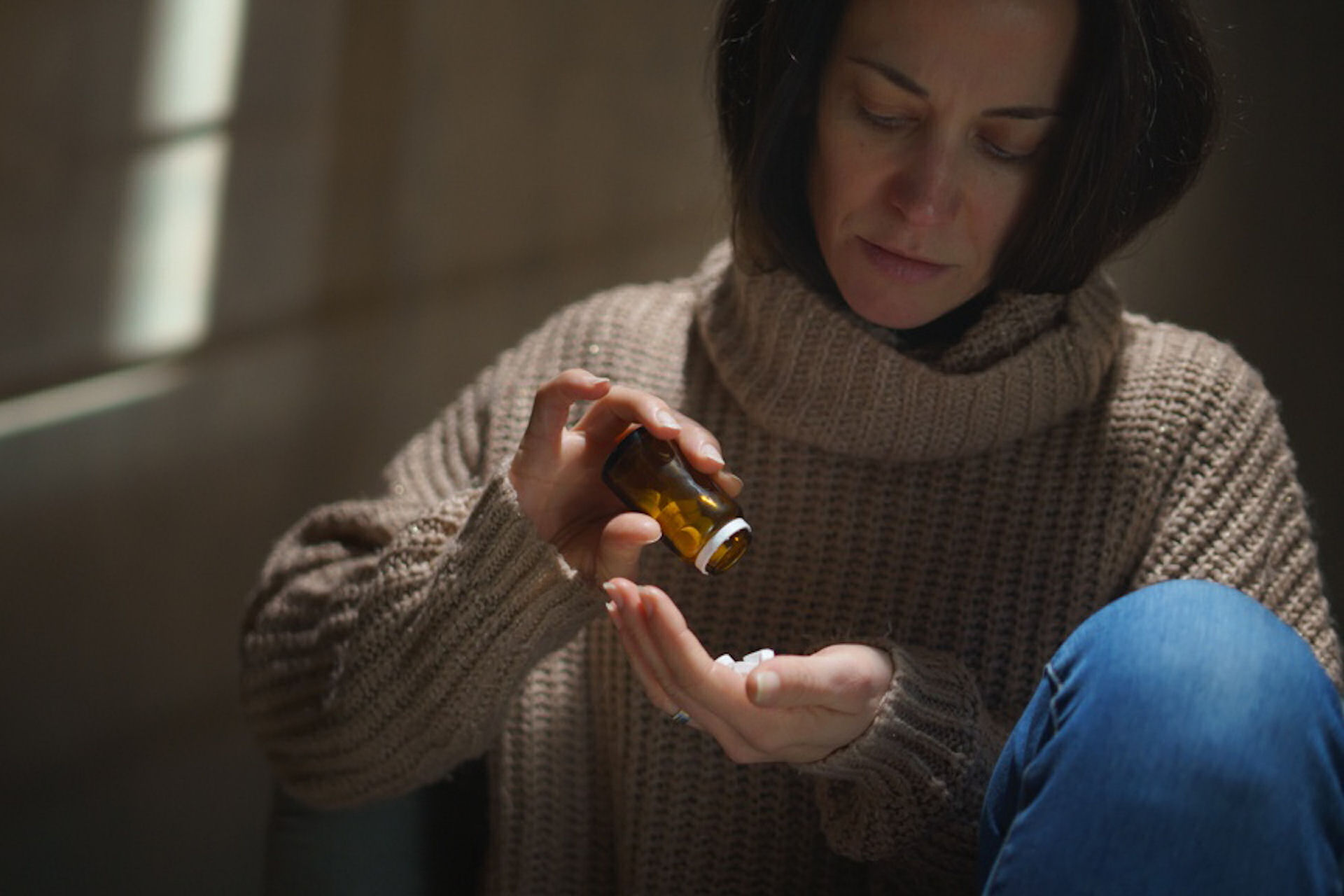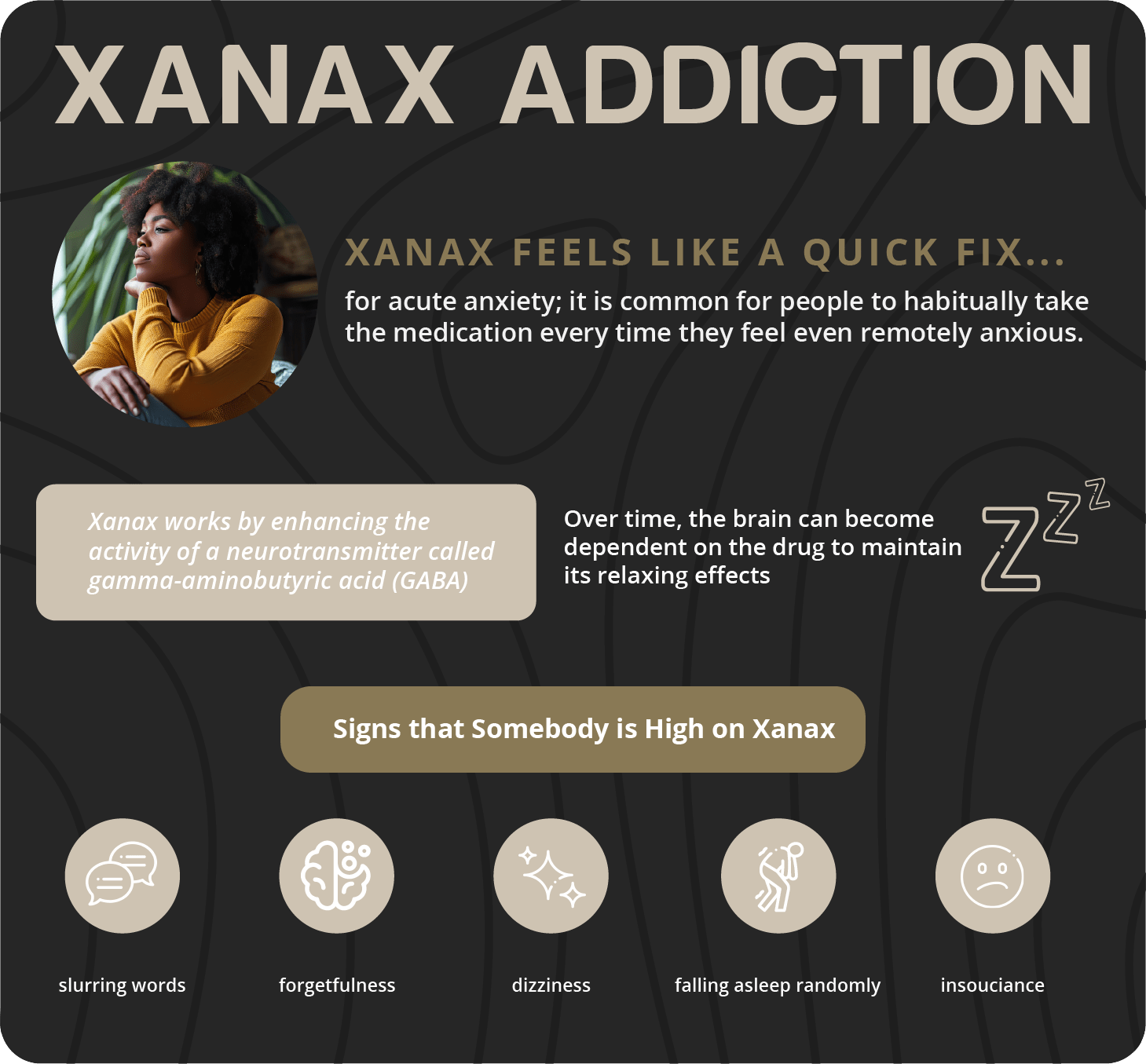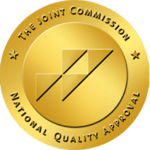Xanax, the brand name for alprazolam, is a benzodiazepine that is commonly prescribed to treat anxiety and panic disorders, as well as insomnia. And when taken as prescribed, it can be an effective tool for managing symptoms. But when misused or abused, it can be highly addictive—and even potentially life-threatening.
Many of us have heard about the dangers of Xanax addiction, but in this article, we will dig deeper into the facts surrounding Xanax and its potential for dependence. We will explore the risks, the signs to look out for, and, most importantly, what can be done if someone has become dependent on this medication.
What Is Xanax and How is it Used?

However, because of its sedative effects, people have been known to abuse Xanax. According to the National Institute on Drug Abuse (NIDA), Xanax is one of the most commonly prescribed—and abused—benzodiazepines in the United States due to its quick-acting effects and ability to induce a feeling of euphoria. NIDA reported that in 2019, more than 11 million people aged 12 and older misused prescription drugs like Xanax, making it one of the most commonly abused substances in America.
What are the Xanax Addiction Risk Factors?
Xanax can be an effective medication when taken as prescribed, but it’s important to be aware of the risks of taking it.
- Previous Addiction or Family History: Individuals who have a history of drug abuse or who come from a family of substance abusers are more likely to develop Xanax addiction.
- Mental Health Issues: People with mental health conditions such as depression, anxiety, or bipolar disorder may be more likely to abuse Xanax.
- Chronic Stress: Individuals who experience chronic stress or trauma may be more likely to abuse Xanax to cope with their feelings.
- Dosage and Duration of Use: The longer and higher the dosage of Xanax use, the higher the risk of addiction.
- Age: Young adults and teenagers are more likely to become addicted to Xanax than older people.
- Polydrug Use: Individuals who use multiple drugs, including Xanax, are at a higher risk of addiction.
 What Indicates a Xanax Addiction?
What Indicates a Xanax Addiction?
Individuals who are becoming addicted to Xanax may indicate a variety of physical and psychological symptoms, which may include the following:
- A sudden change in sleep patterns and insomnia.
- Slurred speech.
- Agitation, irritability, and restlessness.
- Poor coordination or impaired motor skills.
- Elevated heart rate and blood pressure levels.
- Shallow breathing or difficulty breathing normally.
- Slowed reflexes or reactions to stimuli in the environment.
- Dizziness or fainting due to lack of oxygen reaching the brain due to suppressed breathing habits caused by Xanax abuse or addiction.
- An intense craving for the drug, even when it’s not being used or needed medically
- An inability to control impulse actions while taking the drug regularly
- Mania-like behavior like feeling overly happy, excited, energized, or hyperactive after taking Xanax unexpectedly
- A false sense of security when under the influence of Xanax
Different indications and symptoms of Xanax addiction may appear in different people. An individual could experience one or more of the indications mentioned. If you believe you or a loved one is going through any of these symptoms, it’s crucial to get quick help.
Xanax Dosage and Administration: How to Take?
When it comes to taking Xanax, there are some important things you should know.
- Xanax is typically prescribed as an oral tablet that you take with a glass of water,
- The dosage is determined by your doctor based on your age and medical condition. Common Xanax doses range from 0.25 mg to 4 mg. The amount can vary depending on the severity of your condition.
- Alcohol and other sedatives should not be used while taking Xanax. Doing so can increase the effects of the drug, thus increasing the risk of overdose and other potential complications.
- If you are currently on another medication, inform your doctor before taking Xanax. This includes prescription medications as well as over-the-counter medications and vitamins.
Can Someone Overdose on Xanax?
Yes! It’s possible to overdose on Xanax, and this is something you should be aware of if you take it or have friends who take it. According to a survey conducted by the National Institute on Drug Abuse (NIDA), more than 18 million people in America have abused prescription drugs at some point in their lives, making it one of the biggest health crises facing us today. Xanax abuse is a part of it.
Usually, a Xanax overdose occurs when someone takes too much of the drug, either intentionally or accidentally. But sometimes it can happen because the person has built up a tolerance to the drug and needs more to get the same effect as before. Overdose signs typically include difficulty breathing, confusion, drowsiness, and impaired coordination, so if you see someone exhibiting these symptoms after taking Xanax, seek medical help immediately!
Of course, people can also overdose by combining Xanax with other drugs like opiates, benzodiazepines, or alcohol. If you’re taking any kind of medication that contains benzodiazepines—including Xanax—avoid drinking alcohol at all costs and make sure you only use your medications as prescribed by your doctor.
Using Xanax With Other Substances
Using Xanax with other substances can be incredibly dangerous. It can cause respiratory depression, increase the risk of overdosing, and even lead to death.
Some common substances that may be abused when taken together with Xanax include the following:
- Alcohol: The combination of Xanax and alcohol increases the risk of overdose, respiratory depression, and excessive drowsiness.
- Opioids: There is an increased risk of respiratory depression and overdose when Xanax is used with opiates like heroin, oxycodone, or fentanyl.
- Stimulants: Combining Xanax with stimulants such as cocaine or methamphetamine can lead to dangerous heart and respiratory effects.
- Marijuana: Combining Xanax with marijuana can increase soothing effects and impair cognitive functioning.
- Prescription drugs: Using Xanax with other prescription drugs such as benzodiazepines, sleeping pills, or muscle relaxants can lead to dangerous interactions and an increased risk of overdose.
It’s worth noting that this risk increases when using illicit drugs because you won’t know the ingredients or potency you’re dealing with. So as a general rule, mixing any kind of drug without professional supervision is never a good idea.
Withdrawal Symptoms of Xanax
When it comes to the withdrawal symptoms of Xanax, these are known to be notoriously tough. Depending on how long you’ve been taking Xanax and the amount taken, this can cause issues such as seizures and even death if not managed correctly.
The effects of short-term Xanax withdrawal can include:
- Anxiety
- Insomnia
- Agitation
- Stress
- Headaches
- Muscle tension
- Panic attacks
- Memory and concentration difficulties
The effects of long-term Xanax withdrawal can include:
- Depression
- Irritability
- Suicidal thoughts
- Poor concentration
- Severe mood swings
- Paranoia and psychosis
- Tremors or shakiness in hands and arms
- Hallucinations and seizures
It’s important to know that if someone is attempting to quit taking Xanax, they should seek medical help from a professional. Trying to quit “cold turkey” (without medical assistance) can be very dangerous, especially due to the strong potential for experiencing intense withdrawals that may require medical attention.
Why Do People Abuse Xanax?

- The main reasons why people abuse Xanax are to numb emotional pain or to get high which are the opposite of stress and anxiety.
- Xanax is widely prescribed and widely available, and people mistakenly believe that it is not dangerous or addictive if used in large doses.
- Xanax can produce a feeling of euphoria and relaxation that some individuals may seek for recreational purposes.
- Xanax can cause drowsiness and help individuals fall asleep, which some people may misuse to aid in sleep.
- Some individuals may abuse Xanax due to social pressure or influence from friends or peers.
- Individuals with tolerance to Xanax may need to use it more frequently or at higher doses.
- Some individuals may misuse Xanax as self-medication to treat symptoms of other mental health conditions, such as depression or bipolar disorder, without proper medical supervision.
What are the Effective Treatment Options for Xanax Addiction?
If you are struggling with Xanax addiction, know that you are not alone and that there is help out there! Treatment for Xanax addiction often includes a combination of medication, counseling, and other supportive services.
Medications are typically prescribed to manage withdrawal symptoms and reduce Xanax addiction. These medications may include benzodiazepine agonists or partial agonists that work by interacting with the same neurotransmitters as Xanax but without producing the same elevation in mood.
However, it is important to note that medication should be used in conjunction with other evidence-based therapies, such as behavioral therapy and counseling, to address the underlying issues that contribute to addiction.
Counseling is also an important part of recovery. Through this kind of treatment, individuals can discover the root causes of their Xanax addiction and discover effective solutions to address them to avoid relapse. Cognitive-behavioral therapy, dialectical behavior therapy, and motivational interviewing are popular forms of counseling used to treat Xanax addiction.
Counseling can be provided in various settings, including inpatient and outpatient treatment programs. It is an effective way to address the emotional and psychological aspects of addiction and promote lasting recovery.
Support systems such as support groups, 12-step programs, and other types of community-based resources are also important components of successful treatment for Xanax addiction. It offers individual guidance and support throughout the recovery process. However, these treatments must be tailored to individual needs to be successful. A professional should be consulted before beginning any treatment program for Xanax addiction.
Holistic therapies such as yoga, meditation, acupuncture, and art therapy can help individuals reduce stress and improve their overall well-being during recovery.
It’s important to note that the best treatment approach for Xanax addiction will vary depending on the individual’s needs and circumstances. A comprehensive and individualized treatment plan that addresses the physical, psychological, and social aspects of addiction is often the most effective approach. Seeking professional help from a qualified healthcare provider is highly recommended.
Statistics and Facts about Prescription Drug Abuse & Xanax Addiction
It’s no secret that Xanax is one of the most commonly abused prescription drugs—but let’s take a closer look at just how powerful an impact this drug can have and understand why it is so addictive.
Data from the National Institute on Drug Abuse (NIDA) gives us an idea of how serious this problem is in the United States. According to their stats:
- An estimated 6.2 million people misused benzodiazepines (including Xanax) in the past year.
- Addiction to Xanax is a significant issue, as it’s the 5th most prescribed drug in the U.S. and can be highly addictive.
- The average number of people addicted to Xanax takes 20 to 30 pills each day.
- Due to Xanax abuse, 125,000 people get into the emergency room every year.
- 33% of long-term Xanax users claim that mental health disorders including depression are becoming more prevalent.
- 49% of teenagers use Xanax together with other drugs.
Receive Help at Westwind Recovery®
Westwind Recovery® offers a comprehensive and holistic approach to addiction treatment that includes individualized treatment plans, evidence-based therapies, and supportive aftercare services. If you or someone you know is struggling with Xanax addiction, contact our team now! Our compassionate and experienced staff is dedicated to helping individuals overcome addiction and achieve lasting recovery!

Dr. Deena is the Chief Clinical Officer of Westwind Recovery®, an award-winning outpatient treatment center in Los Angeles where she oversees the clinical and administrative program and treatment methods. Dr. Deena is a doctor of psychology and licensed clinical social worker since 1993. LCSW #20628. Originally from the East Coast, Dr. Deena has worked running treatment centers, worked as a therapist in psychiatric hospitals as well as school settings and currently has a thriving private practice in the LA area. Dr. Deena has appeared regularly on the Dr. Phil Show as an expert since 2003. She has also been featured on many other TV shows, podcasts and has contributed to written publications as well as podcasts.

 What Indicates a Xanax Addiction?
What Indicates a Xanax Addiction?

